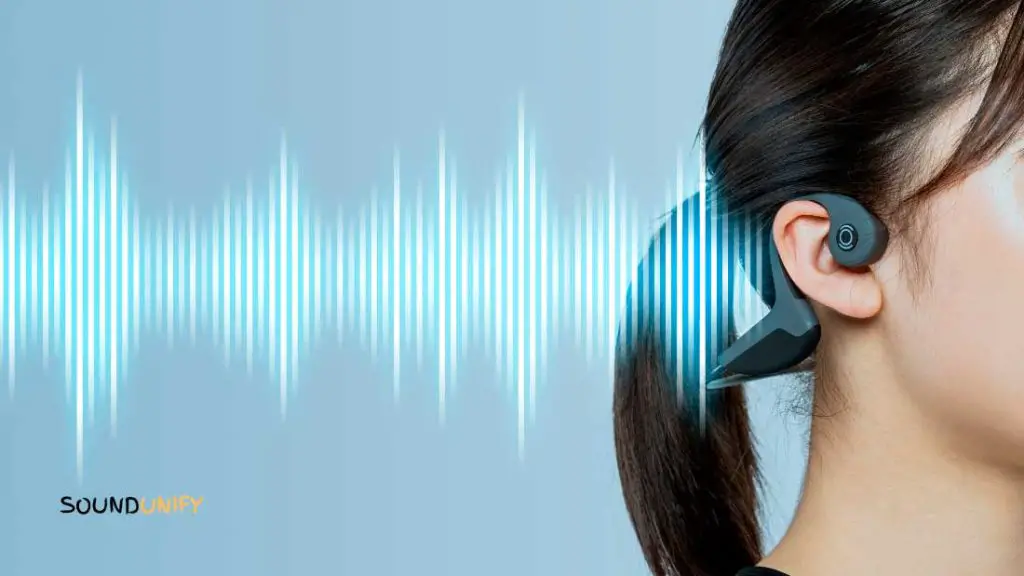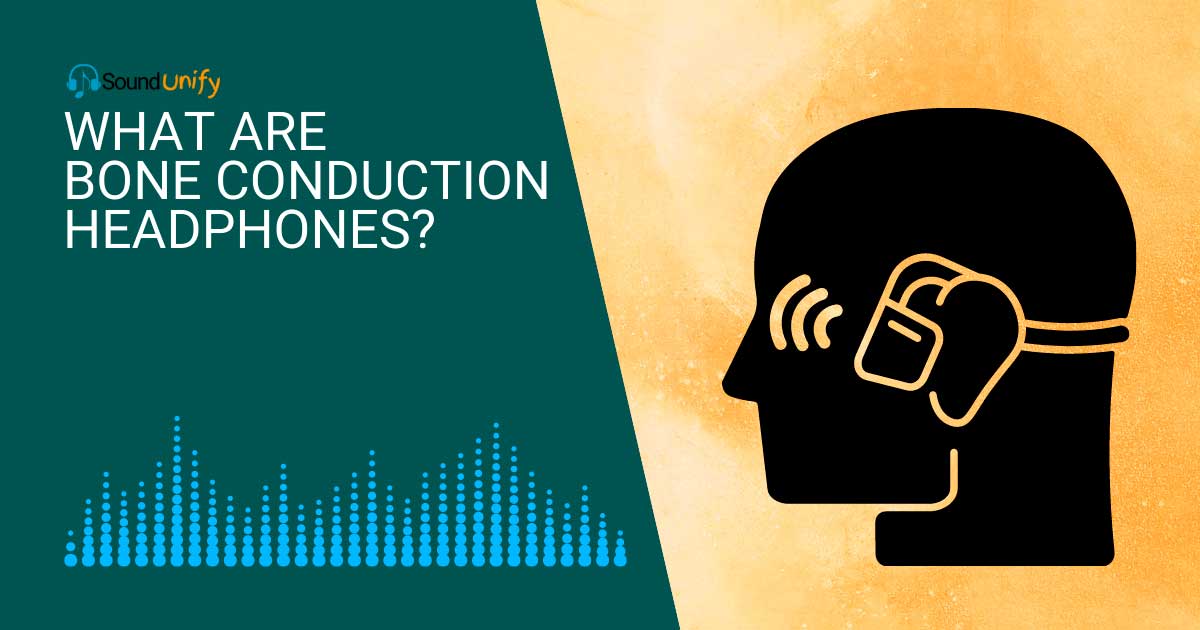Bone conduction headphones are audio devices that rest in your cheekbones and use vibrations to send sound waves directly to the inner ear. They bypass the eardrum to receive sound waves, which makes them ideal for people with hearing impairments.
Bone conduction headphones are also beneficial for people who want to avoid damaging their eardrums with a loud noise. Also, if you love to listen to music while sleeping, then bone-conduction headphones good for your sleep.
They are an alternative to traditional headphones and can use them in various settings, including during exercise and noisy environments.
Bone conduction headphones have pros and cons, but overall, they offer many benefits over traditional earphones and headphones.
Read on to learn more about bone-conduction headphones and decide if they’re right for you.

How Does Bone Conduction Work?
The technology behind bone conduction is actually quite simple. The sound waves travel through your bones and inner ear when you speak. So, people with hearing aids that use bone conduction can still hear even in a noisy environment.
Bone conduction is the transfer of sound waves through the bones of the skull to the inner ear. The eardrum is never involved since this technology decodes sound waves and turns them into vibrations that the Cochlea directly receives. This process bypasses the outer and middle ear, making it an effective way to hear for people with hearing loss.
So you can get a clear, high-quality audio experience free from interference. Some models even come with an ambient noise cancellation feature. It ensures you will never miss a beat when listening to your favorite music.
Additionally, bone conduction headphones are smaller and more discreet than other headphones, making them ideal for travel or everyday use.
Benefits Of Bone-Conduction Headphones?
Bone conduction headphones offer a high degree of comfort because they put less pressure on your ears. These headphones have many benefits. Such as
1. Helpful for People with Hearing Loss
Hearing loss is quite isolating, as it can make it difficult to stay connected with the world around you. Bone conduction headphones are an excellent way to overcome this problem and keep up with your daily tasks without raising your voice.
This technology transmits sound directly into the ear canal through the bone rather than airwaves, as in traditional headphones.
So, people who suffer from hearing loss benefit massively as they do not have to adjust their volume or audio quality settings. Instead, just put on a pair of headphones and listen comfortably.
2. Comfortable and Snug Fit
Traditional over-ear or in-ear headphones can significantly hurt your earlobes if you wear them too long. Moreover, if you wear the wrong-sized headphones, they will fall from your head or hurt your ear tremendously.
However, bone-conducting headphones are free from those difficulties. As they rest on your cheekbones, your ear and earlobes are free from touching the headphones. So, no doubt that it is comfortable and fits perfectly.
3. Completely Wireless
Bone conduction headphones are the perfect option if you are in the market for entirely wireless headphones. They do not require any cables to be connected, making them convenient and easy to use. Moreover, they provide an immersive audio experience for watching movies or listening to music.
4. Don’t Cause Ear-Wax Build-Up or Ear Infections
A lot of dirt and dust can get stuck on the Earbuds, leading to ear infections. Earbuds help to collect dirt quickly in the ear due to sticking to the ear. As a result, ear wax builds quickly in your ear.
But bone conduction headphones cannot enhance ear wax build-up as they don’t touch your ear canals directly.
5. Waterproof
Many models of bone conduction headphones come in a variety of different versions – including completely waterproof ones. That makes them ideal for those who spend a lot of time on their feet or engage in other water activities.
Shokz OpenRun Pro is completely waterproof, fits comfortably in a larger head, and hangs to the neck a little too much. It is best for swimming and doing other hardcore workouts.
Disadvantages of Bone-Conduction Headphones

Bone conduction headphones are becoming increasingly popular as they offer many advantages over traditional earphones.
The main downside is that bone conduction headphones don’t provide a good seal if you’re wearing them while running or traveling, which can result in lower sound quality.
However, bone-conduction headphones are definitely the best option if you’re an active listener and can stay still while wearing them.
1. Pricey
Bone conduction headphones are expensive. This is because they have features that other headphones do not have, and their technology is new. They can cost anywhere from $60 to $250, which is quite expensive. So, if you have a tight budget, those are might not for you.
2. Lower Sound Quality
When it comes to headphones, most people tend to think of earbuds and over-ear headphones. However, bone-conduction headphones are a different story altogether.
Bone conduction technology transmits sound through the bones in your skull rather than using eardrums, or airwaves like other types of headphones do.
As a result, bone-conduction headphones have a lower sound quality than earbuds and over-ear headphones. Additionally, they’re not recommended for people who work in crowded environments because they will drown out the sound.
3. Can Leak Sound
Many people tend to go for traditional earbuds or in-ear earphones when it comes to headphones. Other types of headphones offer better sound quality and are more discreet.
Bone conduction headphones work by sending sound waves directly into your inner ear canal instead of through your ears like regular headphones do.
As a result, other people in the same room may be able to hear what you’re listening to – not great if you’re looking for an inconspicuous way to listen to music or watch TV.
How To Choose The Best Bone-Conduction Headphones?

There are a few things to consider when purchasing bone-conduction headphones.
- Comfort: You need to ensure that the headphones fit snugly and comfortably over your ears.
- Sound Quality: You also want to ensure that the headphones have good sound quality so you can enjoy your music or movies to the fullest.
- Purpose: Think about what you will be using them for. If you are an active user who likes to run or bike, you will want to make sure the headphones are sweat-resistant and secure. You may also want to consider Bluetooth connectivity and battery life.
- Design: Look at the different styles and designs to find the best fit for you. Some headphones are designed to sit behind the ear, while others wrap around them. There is no right or wrong answer here. It is simply a matter of preference.
- Price: Compare prices from different retailers before making your final decision. Bone conduction headphones can range in price from $50 to $200, so it is important to find the pair that fits your needs and budget.
FAQ
Q. What are Bone-Conduction Headphones?
Bone conduction headphones are a type of audio device that uses vibrations to send sound waves directly to the inner ear. That bypasses the eardrum and middle ear, which means that people with hearing loss and tinnitus can still enjoy music, movies, and other audio content.
Q. How do I choose the perfect pair of bone-conduction headphones for my needs?
To choose the perfect pair of bone-conduction headphones for your needs, you should consider the following factors:
The type of activities you’ll be using them for. If you are using them for running or other high-impact activities, you have to make sure the headphones are designed for that.
Your budget. Bone conduction headphones can range in price from around $60 to $250.
The fit. Bone conduction headphones should fit snugly and securely so that they don’t move around or fall off while using them.
The sound quality. Make sure to read reviews to find out what other users think of the sound quality of the headphones you’re considering.
Q. Are there any disadvantages to using bone conduction headphones?
There are a few disadvantages to using bone-conduction headphones. 1. First, they are generally more expensive than traditional headphones.
2. They may not be as effective at blocking out external noise.
3. Lastly, bone-conduction headphones do not have a long battery life, so be sure to bring a spare battery with you when you’re out and about.
Q. Is it safe to use Bone Conduction Headphones while working out or exercising?
Yes, using bone-conduction headphones while working out or exercising is safe. Bone conduction headphones allow you to hear your music or other audio without blocking your ears, which can be beneficial if you need to be aware of your surroundings while working out or exercising. Moreover, bone-conduction headphones are less likely to cause ear fatigue than traditional headphones.
Conclusion
Bone conduction headphones are a great way to listen to music without damaging your ears. They are also perfect for people who have hearing problems or are hard of hearing. You can also use them to make phone calls and other applications requiring sound.
With bone-conduction headphones, you can enjoy your music without worrying about the consequences. If you are considering purchasing a pair of headphones, research the different available types to find the best fit.
James Dimento is a Chief-in-Editor of SoundUnify. He is a headphone enthusiast and creative writer passionate about audio technology. He has three years of experience writing about headphones and sound quality and is responsible for creating reviews and taking care of all administration.
